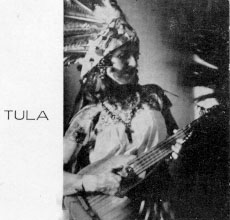- Gertrude Prokosch Kurath
Infobox Person
name = Gertude Prokosch Kurath
image_size = 230
caption = Kurath, under her stage name of Tula, 1948
birth_name =
birth_date = birth date |1903|08|19
birth_place =Chicago, Illinois
death_date = death date and age|1992|08|01|1903|08|19
death_place =
death_cause =
resting_place =
resting_place_coordinates =
residence =
nationality = USA
ethnicity =
citizenship =
other_names = Tula
known_for =
education =Yale School of Drama
alma_mater =Bryn Mawr
employer =
occupation = Dancer, ethnomusicologist
home_town =
title =
salary =
networth =
height =
weight =
term =
predecessor =
successor =
party =
boards =
religion =
spouse =
partner =
children =
parents =
relations =
website =
footnotes =Gertrude Prokosch Kurath (1903-1992) was an American
dance r, researcher, author, andethnomusicologist . She researched and wrote extensively on the study of dance, co-authoring several books and writing hundreds of articles. Her main areas of interest wereethnomusicology anddance ethnology , with some of her best known works being "Panorama of Dance Ethnology" in "Current Anthropology " (1960), the book "Music and dance of the Tewa Pueblos" co-written with Antonio Garcia (1970), and "Iroquois Music and Dance: ceremonial arts of two Seneca Longhouses" (1964), in the "Smithsonan Institution Bureau of American Ethnology bulletin". She made substantial contributions to the study ofAmerindian dance, and to dance theory. From 1958 to January 1972 she was dance editor for the journal "Ethnomusicology".Biography
Kurath was born in
August 19 1903 inChicago, Illinois . [cite journal|title=Gertrude Prokosch Kurath August 19, 1903-August 1, 1992|author=Kealiinohomoku, Joann|journal=Dance Research Journal |volume=24|number=2|date=Autumn 1992|pages=p. 70|publisher=University of Illinois Press on behalf ofCongress on Research in Dance ] She graduated fromBryn Mawr College , receiving a BA in 1922, and an MA in art history in 1928, concurrently studying music and dance in Berlin, Philadelphia, New York, and Providence, Rhode Island from 1922-1928. She then studied music and dance at theYale School of Drama atYale University , from 1929-1930. She danced under the stage name of Tula, starting in 1922. From 1923-1946 she was a teacher, performer, producer, and choreographer ofmodern dance . In the mid-1940s, she turned her focus to the study ofAmerican Indian dance, doing extensive fieldwork on the musical traditions of Michigan'sAnishinaabe and others. [ [http://www.sisbok.no/vare.php?ean=9780870138140 Art of Tradition] ] She was awarded grants for field research by theWenner-Gren Foundation from 1949-1973, theAmerican Philosophical Society from 1951-1965, and theNational Museum of Canada (1962-1965, 1969-1970). She wrote aboutIroquois ,Pueblo ,Six Nations , andGreat Lakes Indian dances, as well as on the subjects ofdance theory and methods. In 1962, she founded the Dance Research Center inAnn Arbor, Michigan . [cite web|url=http://phonoarchive.org/grove/Entries/S15685.htm|title=Kurath, Gertrude Prokosch (Tula)|author=Dyen, Doris J.|publisher=phonoarchive.org|accessdate=2008-06-01]Her other scholarly interests included the fields of folk liturgy and rock music. Robert Commanday of "
San Francisco Chronicle " praised her addition to "The New Grove Dictionary of American Music ", [cite book|title=The New Grove Dictionary of American Music|format=4 volumes|pages=2635 pages|publisher=Grove's Dictionaries of Music, Inc.|date= 1986-11-03] saying, "For the first time in the country's history, a comprehensive survey of its music and musicians is available in a single reference work. It encompasses the spectrum, the fields of concert, opera, traditional, folk and popular music, and areas related to and touching on American music in every conceivable way - industry, technology, education, religion, literature... Two treatments must be singled out as unique and outstanding. One is the 20-page study on "Indians, American" by Bruno Nettl and Charlotte Heth on the music, Gertrude Kurath on the dance. In addition, there are separate articles on the music of nearly 40 tribes and tribal groups. Equally impressive is the 22-page article on "European-American Music," treating in sequence the musical cultures and influences here of 19 European countries." [cite news|title=2635 Pages of Musical Americana|work=The San Francisco Chronicle |date=1986-11-16|author=Commanday, Robert]Kurath died on
August 1 ,1992 . Her archives are maintained atCross-Cultural Dance Resources inArizona , which published her work "Half a Century of Dance Research". [cite journal|author=Novack, Cynthia J.|title=Review: "Half a Century of Dance Research: Essays by Gertrude Prokosch Kurath"|journal=Ethnomusicology|url=http://www.jstor.org/pss/852180|volume=33|number=1|date=Winter 1989|pages=pp. 158-161|publisher=University of Illinois Press on behalf ofSociety for Ethnomusicology ] The Iroquois materials are housed in the Woodlands Cultural Centre inBrantford, Ontario .Honors
* 1972, CORD (Congress on Research in Dance)
* 1986, UCLA Association of Graduate Dance Ethnologists
* 1987, Society for Ethnomusicology
* 2001 (posthumously), Society for Ethnomusicology
* 2001, Michigan State University Museum Heritage Awardelected works
* Kurath, Gertrude Prokosch; Garcia, Antonio. "Music and Dance of the
Tewa Pueblos ", 1970 [cite news|title=A few notable "Daughters of the Desert"|work=The Santa Fe New Mexican |date=1998-04-12]
* Gertrude Prokosch Kurath / Jane Ettawageshik / Fred Ettawageshik / Michael D. McNally / Frank Ettawageshik, "Sacred Music, Dance, and Myth of Michigan's Anishinaabe, 1946-1955"
* Kurath, Gertrude Prokosch. "Half a Century of Dance Research"
* Helm, June, Nancy Oestreich Lurie, and Gertrude Prokosch Kurath. "The Dogrib Hand Game". Ottawa: [Queen's Printer] , 1966.
* cite journal
last = Kurath
first = Gertrude Prokosch
title = Dance Relatives of Mid-Europe and Middle America: A Venture in Comparative Choreology
journal =The Journal of American Folklore
volume = 69
issue = 273, Slavic Folklore: A Symposium
pages = 286–298
date = Jul.-Sept. 1956
id = ISSN 0021-8715
doi = 10.2307/537145
* cite journal
last = Kurath
first = Gertrude Prokosch
title = Mexican Moriscas: A Problem in Dance Acculturation
journal = The Journal of American Folklore
volume = 62
issue = 244
pages = 87–106
date = Apr.-Jun., 1998
id= ISSN 0021-8715
doi = 10.2307/536304* “Panorama of Dance Ethnology” in "
Current Anthropology " 1960, vol.1, #3, pp. 233-254
*"Music and dance of the Tewa Pueblos" with Antonio Garcia,Museum of New Mexico Press , Santa Fe, NM, 1970
*"Iroquois Music and Dance: ceremonial arts of two Seneca Longhouses", "Smithsonan Institution Bureau of American Ethnology bulletin " 187, 1964References
Further reading
* Charlotte J. Frisbie, 1977, "Music and Dance Research of Southwestern United States Indians" "Detroit Studies in Music Bibliography" number 36.
Information Coordinators, Inc. pp. 30-35.External links
* [http://www.ccdr.org/Collections/GPK_Collection_Guide.pdf Kurath Collection] at
CCDR (pdf)
Wikimedia Foundation. 2010.
